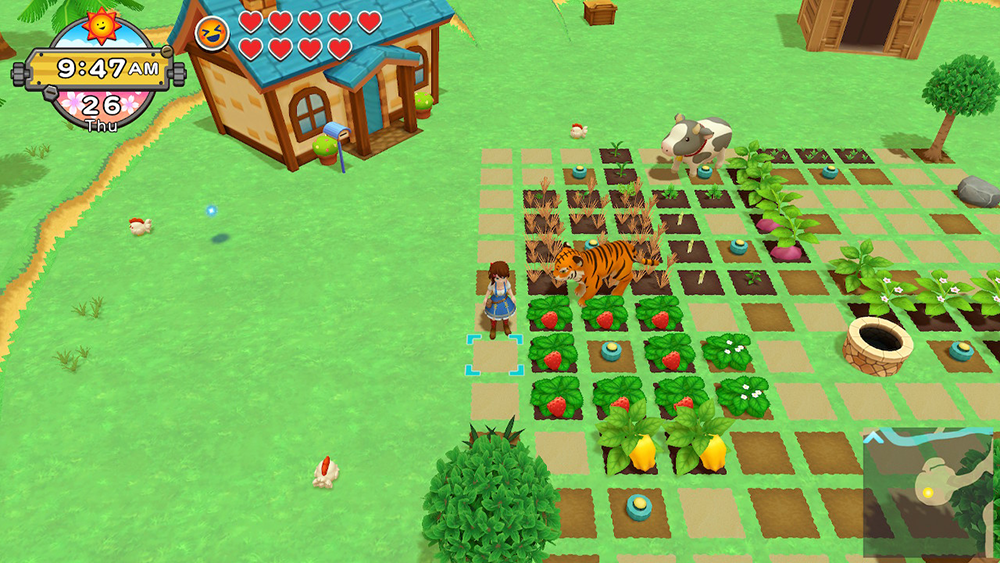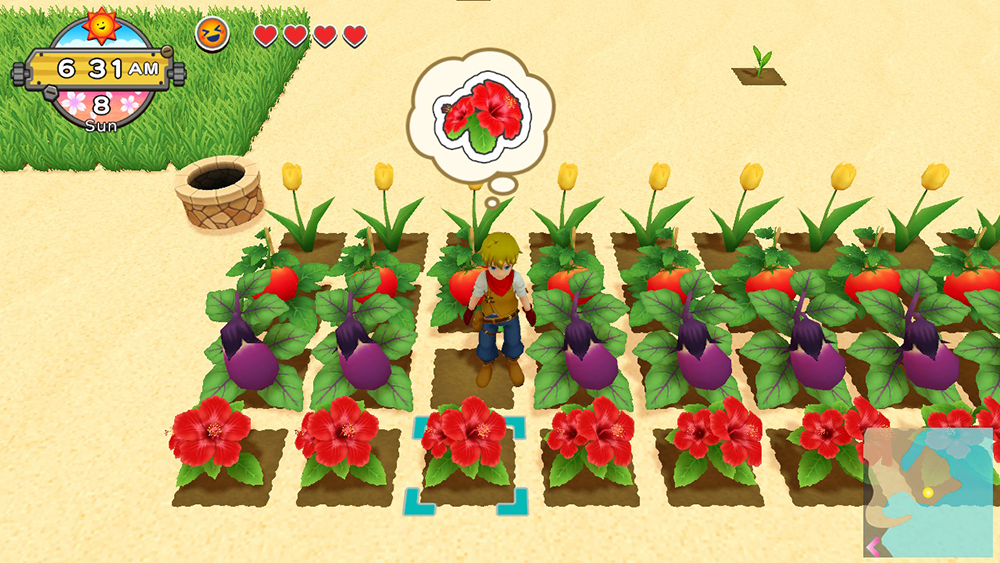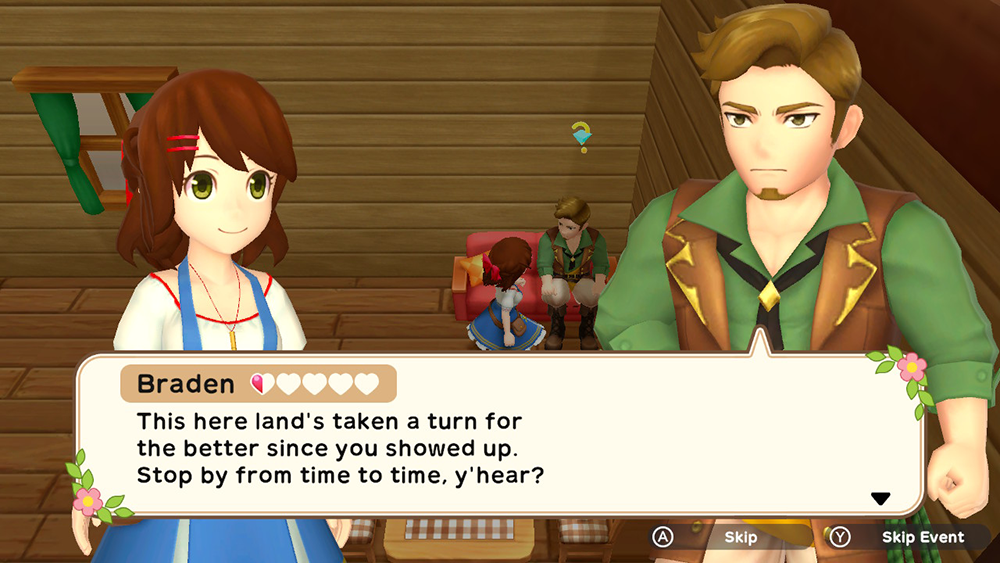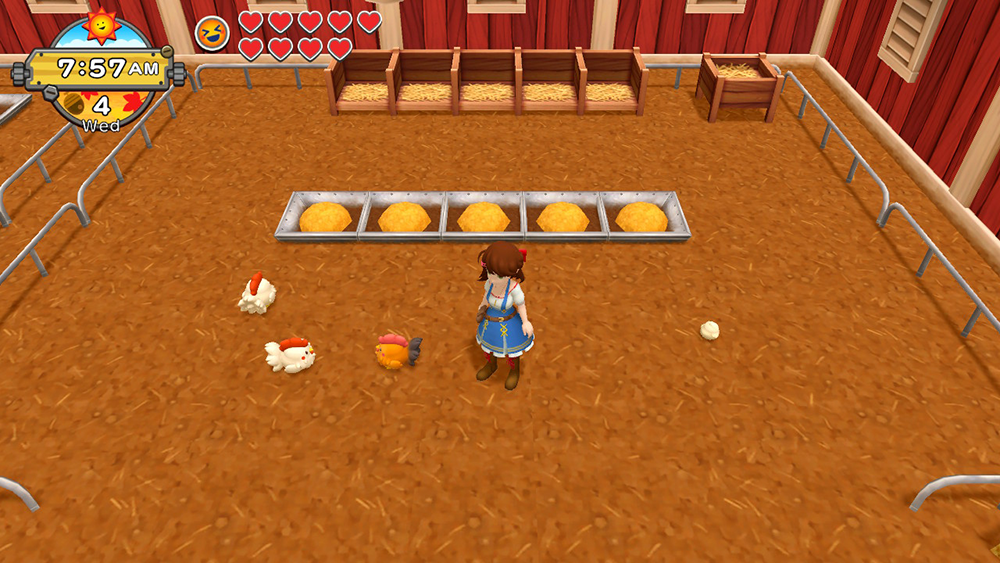Lots of potential... and lots of problems.
Harvest Moon: One World is the newest game in the long-running Harvest Moon series, which offers farming simulation and role-playing gameplay in charming fantasy worlds.
(The Harvest Moon series has a complicated history. The original series of Harvest Moon games from developer Marvelous became “Story of Seasons,” and the current Harvest Moon games are released by a different company, Natsume.)
Harvest Moon: One World is now available on Switch and PlayStation 4 (with an Xbox One version coming later). We had the chance to check out the Switch version of the game.
Harvest Moon: One World takes place in a world where the inhabitants have lost the ability to farm crops and other plants. The world’s “bountiful soil” has disappeared, and players will quickly discover that they’re the only ones who can grow crops, as well as see and interact with special beings called Harvest Wisps and Harvest Sprites. Players will need to complete tasks in order to revive the Harvest Sprites, collect six medallions, and ultimately restore the Harvest Goddess.
At the beginning of Harvest Moon: One World, players can choose to play as a boy or girl, and they can also customize the look of their character and give them a name. From there, they’ll be able to build a farm, grow crops, plant trees, raise animals, go fishing, craft items, go mining for resources, do some cooking, and more in order to complete quests for the world’s characters and progress the main story (side quests are also available). There are lots of features and activities available here, and it will take quite some time for players to see and do it all.
Gameplay in Harvest Moon: One World revolves around an in-game clock and stamina system. In-game time progresses quite quickly, and your stamina will drain as you complete most actions (like planting and watering crops, chopping down trees, destroying boulders, etc.) Even walking around the world will drain your stamina, with certain areas draining your stamina at a faster rate than others (for instance, the game’s desert area has a harsh climate, so it drains your stamina quite quickly — too quickly for our liking).
You can restore some of your stamina by eating crops, as well as dishes that you can cook once you’ve unlocked a kitchen for your home. Your stamina will also be restored when you go to bed each day. If you allow your stamina to run out entirely, you’ll pass out and the game will automatically progress to the next day. When you wake up, you’ll be in poor condition and you won’t have access to your full daily supply of stamina.
After players have completed the basics of caring for their crops and animals each day, this stamina system forces them to decide which of the game’s secondary features to interact with using the stamina and time they have left, since they can’t do everything in a single day (this is still true even after players have unlocked a few maximum stamina increases).
Harvest Moon: One World also features the four seasons, but only some parts of the world will actually experience them, depending on their climate. For instance, the tropical beach community of Halo Halo will remain in a “summer” mode all year long (we’ll talk more about the game’s different regions in a moment).
Rather than purchasing seeds at a store, players can collect seeds by interacting with Harvest Wisps all around the in-game world. Each Wisp carries a single seed, and these seeds aren’t random. This means you can remember the locations of certain Wisps and revisit them each day if you need to stock up on a particular kind of seed. The game’s map also allows you to view the locations of Wisps you’ve previously interacted with by searching for the seed you want to collect.
These Harvest Wisps are a unique gameplay feature, but they’re not without problems. Many of the game’s quests will require you to grow and deliver certain crops/flowers to one of the game’s many friendly characters. While you may be able to find multiple Harvest Wisps that are carrying the same seed, you’ll need to travel to their location(s) each day to collect them, which wastes valuable time (more time than if you were simply allowed to travel to a store and purchase the seeds you need).
This is complicated further by the fact that Harvest Wisps may only appear at certain times during the day. Visit a location too early or too late in the day, and the Wisp you need will not be there. (If you’ve searched for a Harvest Wisp using the map, it will indicate when a Wisp is present and when it is not.)

In Harvest Moon: One World, the in-game world is split into multiple themed regions, which all have different characters to befriend, as well as different seeds to collect and different climates to react to. As we previously mentioned, the game’s desert area — called Pastilla — will quickly drain your stamina, unless you eat or drink something cold to cool your body temperature. Similarly, the snowy region of Salmiakki will quickly drain your stamina unless you eat or drink something warm.
While other farming games may lock the player’s farm to a single location, in One World, you can actually move your farm to each of these regions after you’ve discovered them. This is helpful when you’re in the middle of the story quests for a particular region, since you can move your farm to the area, and you’ll start there each day, rather than being required to travel there each time you need to do something (thereby wasting time and energy).
When players move their farms, they’ll only move their home, barn, and secondary buildings. Any crops they’ve planted will remain behind. Once players have finished a region’s story quests, they’ll unlock the ability to fast travel back to that location at any time. This gives players the ability to manage crops in multiple regions each day. Players can also collect mounts (like horses and reindeer) and ride them around the in-game world, which is much faster than walking.

Another major feature in Harvest Moon: One World is its crop mutation functionality. This causes seeds to randomly mutate when planted in different areas (“random” meaning you won’t know if a crop will mutate or not). SuperParent attended a preview event for Harvest Moon: One World prior to the game’s launch, where we learned that seeds may grow into a variety of crop mutations if planted in different areas. We were given the example of a tomato, which may become an “ice tomato” when grown in a cold climate. In practice, however, the crop mutation seems to be much more random.
Using the tomato as an example, we planted multiple, regular tomato seeds in Halo Halo — the game’s tropical summer location — and had many turn into ice tomatoes, which, in theory, shouldn’t be possible, since Halo Halo is never “cold.”
While crop mutation may not matter for most crops (it’s something for players who want to grow and collect one of everything), we found it difficult to complete multiple quests because the game would randomly mutate crops into something we didn’t need.
As a particular example, one of the game’s main story quests requires players to grow three watermelons. This task took us far too long to complete (and became very frustrating), because our watermelon seeds kept mutating. Since some seeds mutate and others do not, even when grown in the same environment, we eventually completed the task by simply planting a large number of watermelon seeds in the game’s starting area, until we “lucked” into getting three basic watermelons, rather than mutations.
The most frustrating thing about this issue is that it could have easily been avoided if the game’s developers had designed one plot of farmland to never support crop mutations (the game’s starting farm would have been perfect for this). If this were the case, players would have a dependable farm to use when they needed to grow something specific, and they could use the rest of the game’s farmland to grow potential mutations.
This crop mutation feature is a great example of how the unique features in Harvest Moon: One World (like the timed Harvest Wisps) seem to actively fight against players to hinder their progress.
We see so much potential in Harvest Moon: One World, and the core farming gameplay is actually quite fun. But it doesn’t take long to run into issues (both small and large) that throw wrenches into the machine.

This is one of the trickier reviews we’ve written here at SuperParent, since we find ourselves torn between liking the game’s basic features and being frequently annoyed by one of its quirks.
And, unfortunately, there are additional issues we feel it’s important to mention, like the fact that your basic barn can only hold three barn animals and five chickens at once, even though there are far more varieties of animals available to collect. For instance, the game has a fun selection of wild animals that you can tame, like tigers and bears, but if you already own three barn animals, you can only add another after you get rid of an animal that you may have spent considerable time raising and growing attached to (the fact that some animals produce resources like wool and milk adds another wrinkle to this issue). You can eventually double the size of your barn to hold twice as many animals, but it may take you quite a while to unlock this upgrade.
The game also doesn’t teach players how to unlock some of its core features, like fishing, animal breeding, and marriage (each gender has multiple marriage candidates to choose from, and same-sex relationships aren’t supported). Instead, the game expects players to explore every path and building, talk to every person, and experiment to figure it all out on their own. There’s something to be said for encouraging exploration, but we’d appreciate a bit more hand-holding here (and younger players would likely benefit from the extra guidance even more).
Harvest Moon: One World also has a number of technical issues, like stuttering sounds and lagging graphics, especially when you’re riding a mount, or when you’re in Halo Halo near the water. And once we had played for a substantial number of hours, a new bug cropped up that caused conversations to “freeze.” Each time this happens, the game appears to crash for a few seconds before eventually loading the conversation as normal.
Finally, when you’re playing with the Switch in handheld mode, it can be difficult to tell if you’ve watered some of the game’s lush crops, since their leaves cover most of the ground and the crops appear so small on the screen. If you fail to water a crop even one day, it dies. This caused us to lose multiple crops when we didn’t have the Switch docked.

In-game days go by in a matter of minutes, and it’s all too easy to finish a day and say, “I’ll play just one more day,” rather than ending the play session. This is both a compliment to the game (since it probably means you’ve having fun), and a potential cause for concern for kids and other players who may have trouble self-regulating their screen time. If this is a concern for your family, we recommend utilizing each platform’s parental control features to manage your family’s play time.
(For the record, this concern isn’t unique to Harvest Moon: One World. In our experience, the pull to continue for “just one more day” is typical in these kinds of games — see Stardew Valley for another example. And to be especially clear, we’re not necessarily saying this is a negative issue, but it is something parents should be aware of.)
In addition, while Harvest Moon: One World offers family-friendly gameplay, the game doesn’t feature voice acting, so players need to know how to read.
Even with so many flaws, I’ve mostly enjoyed playing Harvest Moon: One World, but it’s important to note that I came into the experience with an existing love for the farming game genre. That being said, I’ll be the first to point out that the game isn’t perfect, and players that don’t have the same love for the genre may not be as willing to tolerate so many gameplay problems.
We could definitely do without some of the game’s unique features that feel punishing rather than fun (like seeds being locked to certain periods of time and the harsh environments that drain your stamina in a flash).
The game could also be friendlier to newcomers by teaching them more about features like mining, fishing, animal breeding, and so on, rather than requiring players to experiment and figure out so much on their own.
Again, I have a number of complaints about Harvest Moon: One World (some more substantial than others), but I was willing to accept the game’s unique quirks and tolerate its issues since I enjoyed the foundational farming gameplay loop. Other players may not be as patient or forgiving, so we can really only recommend Harvest Moon: One World to players who already love farming games and know exactly what they’re getting into.
Harvest Moon: One World is available now on Switch and PlayStation 4 for $49.99. The game is rated E for Everyone by the ESRB.
Disclosure: SuperParent received a code for Harvest Moon: One World for coverage purposes.
Brandy Berthelson has been writing about video games and technology since 2006, with her work appearing on sites including AOL Games, Digital Spy, and Adweek. When she’s not gaming, Brandy enjoys crafting, baking, and traveling with her husband.